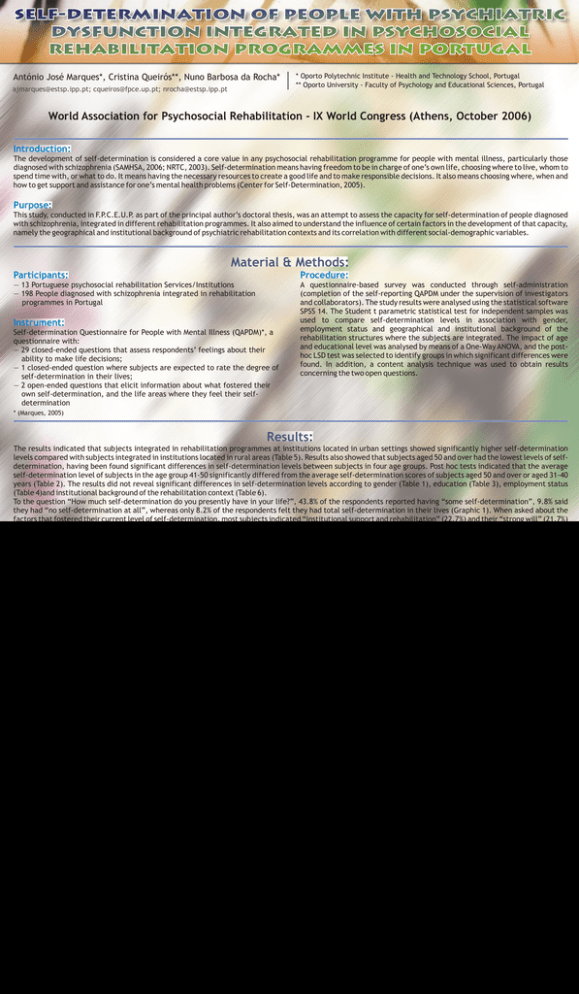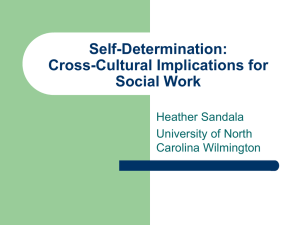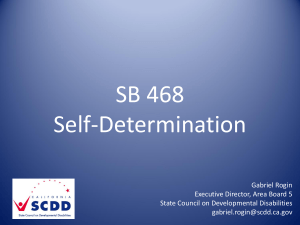PO O RT PO O RT U. - Universidade do Porto
advertisement

Self-Determination of People with Psychiatric Dysfunction Integrated in Psychosocial Rehabilitation Programmes in Portugal | António José Marques*, Cristina Queirós**, Nuno Barbosa da Rocha* ajmarques@estsp.ipp.pt; cqueiros@fpce.up.pt; nrocha@estsp.ipp.pt * Oporto Polytechnic Institute - Health and Technology School, Portugal ** Oporto University - Faculty of Psychology and Educational Sciences, Portugal World Association for Psychosocial Rehabilitation - IX World Congress (Athens, October 2006) Introduction: The development of self-determination is considered a core value in any psychosocial rehabilitation programme for people with mental illness, particularly those diagnosed with schizophrenia (SAMHSA, 2006; NRTC, 2003). Self-determination means having freedom to be in charge of one’s own life, choosing where to live, whom to spend time with, or what to do. It means having the necessary resources to create a good life and to make responsible decisions. It also means choosing where, when and how to get support and assistance for one’s mental health problems (Center for Self-Determination, 2005). Purpose: This study, conducted in F.P.C.E.U.P. as part of the principal author’s doctoral thesis, was an attempt to assess the capacity for self-determination of people diagnosed with schizophrenia, integrated in different rehabilitation programmes. It also aimed to understand the influence of certain factors in the development of that capacity, namely the geographical and institutional background of psychiatric rehabilitation contexts and its correlation with different social-demographic variables. Material & Methods: Participants: Procedure: — 13 Portuguese psychosocial rehabilitation Services/Institutions — 198 People diagnosed with schizophrenia integrated in rehabilitation programmes in Portugal A questionnaire-based survey was conducted through self-administration (completion of the self-reporting QAPDM under the supervision of investigators and collaborators). The study results were analysed using the statistical software SPSS 14. The Student t parametric statistical test for independent samples was used to compare self-determination levels in association with gender, employment status and geographical and institutional background of the rehabilitation structures where the subjects are integrated. The impact of age and educational level was analysed by means of a One-Way ANOVA, and the posthoc LSD test was selected to identify groups in which significant differences were found. In addition, a content analysis technique was used to obtain results concerning the two open questions. Instrument: Self-determination Questionnaire for People with Mental Illness (QAPDM)*, a questionnaire with: — 29 closed-ended questions that assess respondents’ feelings about their ability to make life decisions; — 1 closed-ended question where subjects are expected to rate the degree of self-determination in their lives; — 2 open-ended questions that elicit information about what fostered their own self-determination, and the life areas where they feel their selfdetermination * (Marques, 2005) Results: The results indicated that subjects integrated in rehabilitation programmes at institutions located in urban settings showed significantly higher self-determination levels compared with subjects integrated in institutions located in rural areas (Table 5). Results also showed that subjects aged 50 and over had the lowest levels of selfdetermination, having been found significant differences in self-determination levels between subjects in four age groups. Post hoc tests indicated that the average self-determination level of subjects in the age group 41-50 significantly differed from the average self-determination scores of subjects aged 50 and over or aged 31-40 years (Table 2). The results did not reveal significant differences in self-determination levels according to gender (Table 1), education (Table 3), employment status (Table 4)and institutional background of the rehabilitation context (Table 6). To the question “How much self-determination do you presently have in your life?”, 43.8% of the respondents reported having “some self-determination”, 9.8% said they had “no self-determination at all”, whereas only 8.2% of the respondents felt they had total self-determination in their lives (Graphic 1). When asked about the factors that fostered their current level of self-determination, most subjects indicated “institutional support and rehabilitation” (22.7%) and their “strong will” (21.7%) (Table 7). The main factors referred as impediments to a higher self-determination level (Table 8) included “disease” (30.3%) and “stigma and self-stigma” (17.7%). Table 1. Relation between gender and self-determination level among people with schizophrenia Item Category Male Gender Female N Mean S.D. 140 97.82 17.46 58 98.00 16.67 P Item 0.947 Employment Status Table 2. Relation between age and self-determination level among people with schizophrenia Item Age Category N Mean S.D. 18-30 60 99.92 14.17 31-40 78 95.23 19.00 41-50 43 102.51 17.34 +50 17 91.06 15.09 Table 4. Relation between employment status and self-determination level among people with schizophrenia Item Table 3. Relation between education and self-determination level among people with schizophrenia Institution Geographical Background Educational level N Mean S.D. Compulsory education not completed 71 97.37 18.53 Compulsory education completed 69 98.06 15.10 Secondary education graduate 42 98.90 15.03 Higher education graduate 13 96.46 26.22 P Employed 52 96.25 17.05 Unemployed 119 96.84 17.97 Category N Mean S.D. Urban setting 123 100.74 16.13 Rural setting 75 93.17 18.02 Institutional Background Category N Mean S.D. Psychiatric Hospital 82 98.18 15.83 Community Structure 116 97.66 18.20 0.959 Graphic 1. General self-determination level identified by people with schizophrenia 50 P 0.414 P 1. Institutional support and rehabilitation (22.7%) 2. “Strong will” (21.7%) 3. Family support (15.2%) 4. Job/Professional Training (9.6%) 5. Social support (8.0%) 6. Level of capacity felt (7.6%) 0.003** P 0.832 Table 8. Reasons most reported by people with schizophrenia as aspects that impeded their selfdetermination in general or in a certain area of their lives 1. 2. 3. 4. 5. 6. Disease (30.3%) Stigma and Self-stigma (17.7%) Financial difficulties (14.6%) Inadequate support resources (6%) Lack of job (5.1%) Lack of social support (2.5%) Conclusions: Although the development of self-determination is one of the core factors in any rehabilitation process, this sample apparently reveals that most subjects do not have total control over all aspects of their lives. The multidimensional disability caused by disease, the inherent stigma, and the inefficiency of social responses seem to be the factors that most contribute to this situation. From these people’s point of view, however, psychiatric rehabilitation programmes seem to play a relevant role in promoting their capacity for self-determination. 40 % de persosns S.D. Table 6. Relation between rehabilitation context institutional background and self-determination level among people with schizophrenia Item Category Mean **P<0.010 Statistical differences shown by the post hoc LSD; *P<0.050 Item N Table 5. Relation between rehabilitation institutions geographical background and self-determination level among people with schizophrenia P 0.036 * Category Table 7. Aspects most reported by people with schizophrenia as factors that fostered their self-determination 30 20 10 Bibliography: 0 None Low Some Self-Determ ination level High Total selfdetermination Center for Self- Determination (2005). Comprehensive Guidebooks of Self Determination. Michigan: Center for Self- Determination. National Research and Training Center of Psychiatric Disability, NRTC (2003). Self Determination Tools. Chicago: University of Illinois at Chicago. Substance Abuse and Mental Health Services Administration, SAMHSA (2006). SAMHSA Matrix Priorities: Programs and principles. EUA. U. PORT O FPCEUP FACULDADE DE PSICOLOGIA E DE CIÊNCIAS DA EDUCAÇÃO UNIVERSIDADE DO PORTO ESCOLA SUPERIOR DE TECNOLOGIA DA SAÚDE DO PORTO



